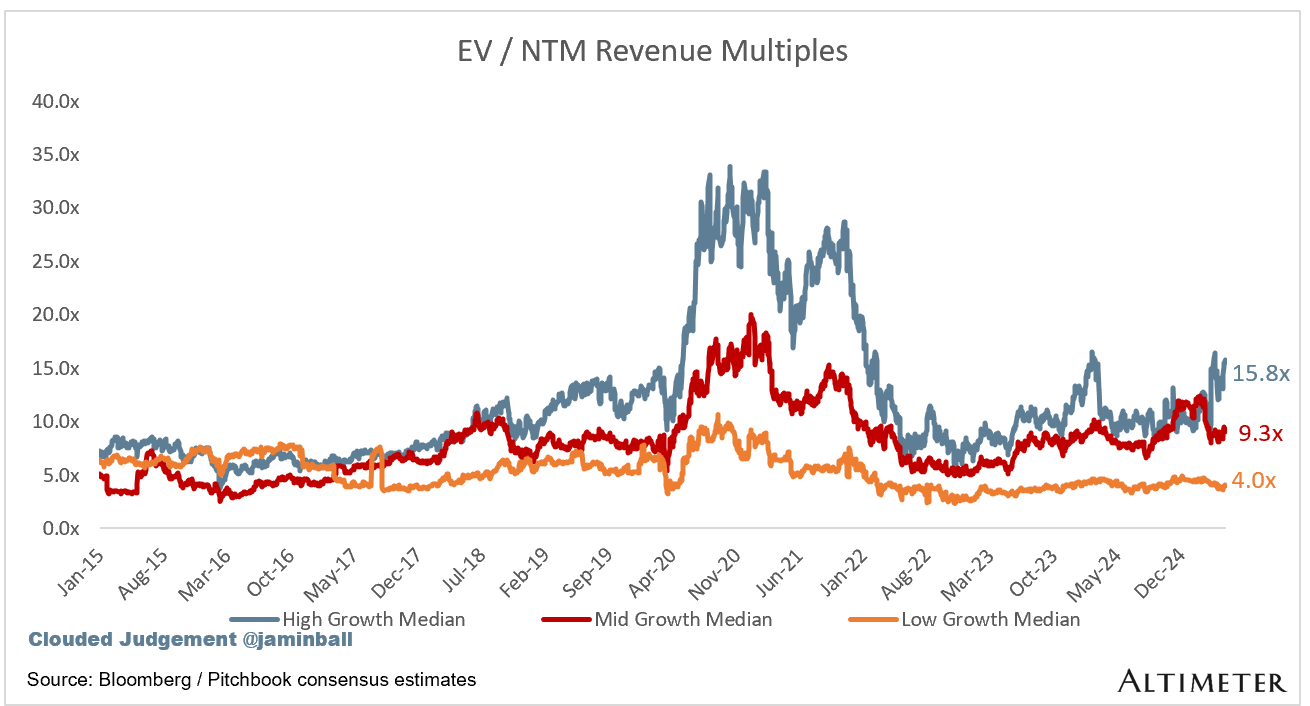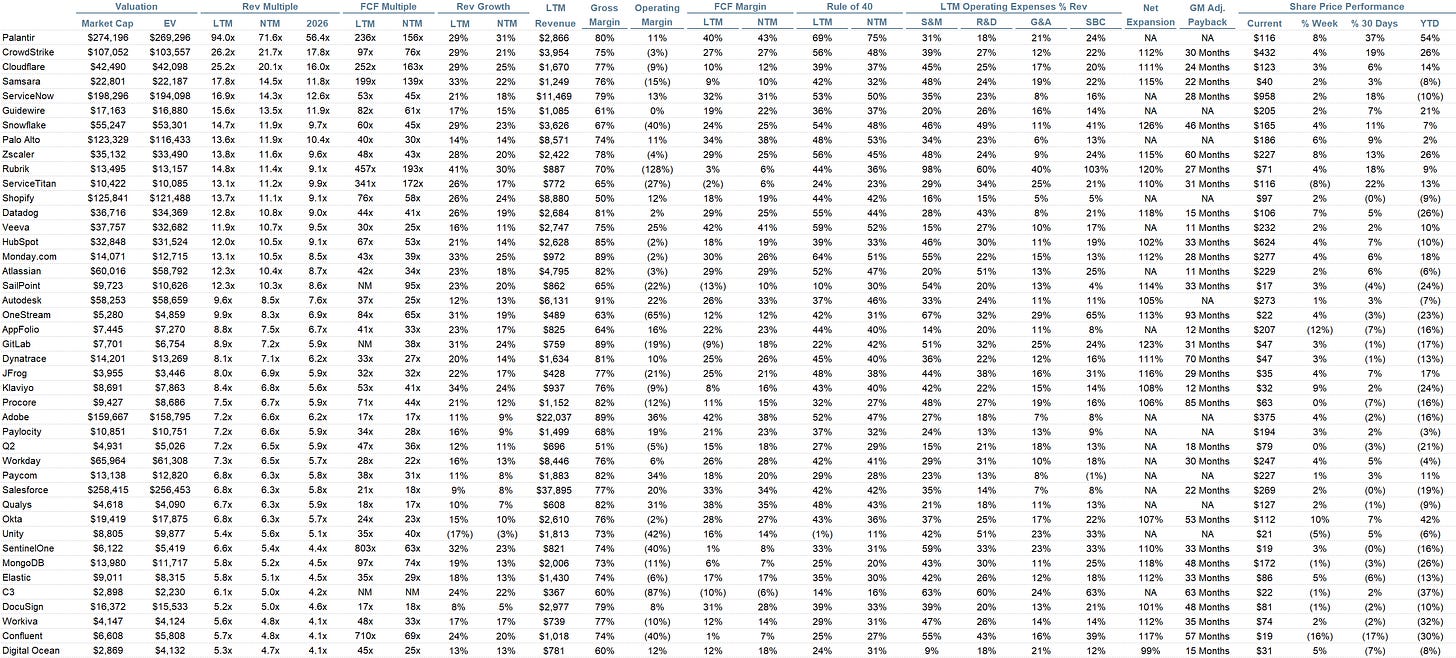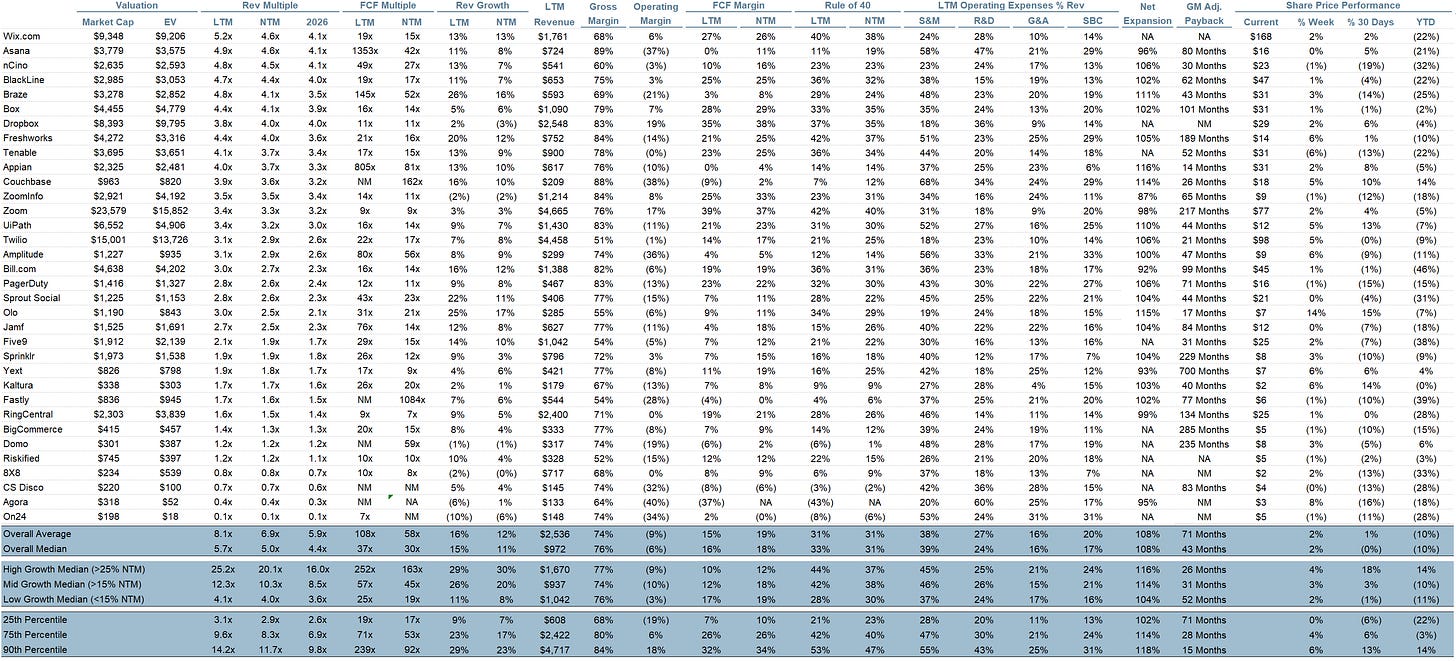Every week I’ll provide updates on the latest trends in cloud software companies. Follow along to stay up to date!
Cloud Giants
Cloud Giants Q1 ‘25 Update:
AWS (Amazon): $xxB run rate growing xx% YoY (last Q grew 19%)
Azure (Microsoft): ~$77B run rate (estimate) growing 35% YoY (last Q grew 31%)
Google Cloud (includes GSuite): $49B run rate growing 28% YoY (last Q grew 30%, neither are cc)
The 3 hyperscalers (Amazon with AWS, Microsoft with Azure, Google with Google Cloud) have now reported. Meta also reported this week. Last week I gave a quick recap of takeaways from Google, this week I’ll look at the other large tech companies to report.
Microsoft came out with a bang. Satya called cloud and AI “the essential inputs to reduce costs and expand output.” Azure saw meaningful acceleration and grew 35% YoY vs expectations of closer to 31% (last quarter they grew 31%). They also guided next quarter Azure growth to be 34-35% and said demand signals remained consistent in April (first month of their next quarter which showed the strength persisted after the quarter end). And surprise surprise, they are still supply constrained! Demand is growing faster for AI services than they can bring resources online to serve the demand. They said “while we continue to bring data center capacity online as planned, demand is growing a bit faster. Therefore, we now expect to have some AI capacity constraints beyond June.” There was a lot of noise about Microsoft canceling data center buildouts / contracts and what they might imply about the demand curve for AI services. Seems like we got the answer this week! Couple other interesting tidbits from their earnings call:
“When it comes to cloud migrations, we saw accelerating demand with customers in every industry”
“We processed over 100 trillion tokens this quarter, up 5x year-over-year, including a record 50 trillion tokens last month alone. And 4 months in over 10,000 organizations have used our new agent service to build, deploy and scale their agents.”
Foundry (model factory) now used by 70 k enterprises; new agent service already at 10 k orgs in four months.
>15 M GitHub Copilot devs (+4× Y/Y); hundreds of thousands of M365 Copilot customers, with a “record number” upsizing seat counts this quarter.
AI services contributed 16 points of the 35 % CC Azure growth; management says it’s getting harder to separate AI from “core” cloud.
Meta also came out with a bang - they raised their CapEx guide to $64-$72b (vs $60-$65b). Both Meta and Microsoft are telling the world “we are buying more and more compute, we’re still supply constrained.”
Amazon re-iterated two themes from the Microsoft call. Cloud migrations re-accelerating, and supply constraints still exist everywhere.
“we continued to see growth in both generative AI business and non-generative AI offerings. As companies turned their attention to newer initiatives, bring more workloads to the cloud, restart or accelerate existing migrations from on-premises to the cloud and tap into the power of Generative AI.”
“as fast as we actually put the capacity in, it's being consumed. So I think we could be driving -- we could be helping more customers and driving more revenue for the business if we had more capacity.”
Quarterly Reports Summary
Top 10 EV / NTM Revenue Multiples
Top 10 Weekly Share Price Movement
Update on Multiples
SaaS businesses are generally valued on a multiple of their revenue - in most cases the projected revenue for the next 12 months. Revenue multiples are a shorthand valuation framework. Given most software companies are not profitable, or not generating meaningful FCF, it’s the only metric to compare the entire industry against. Even a DCF is riddled with long term assumptions. The promise of SaaS is that growth in the early years leads to profits in the mature years. Multiples shown below are calculated by taking the Enterprise Value (market cap + debt - cash) / NTM revenue.
Overall Stats:
Overall Median: 5.0x
Top 5 Median: 20.1x
10Y: 4.2%
Bucketed by Growth. In the buckets below I consider high growth >27% projected NTM growth (I had to update this, as there’s only 1 company projected to grow >30% after this quarter’s earnings), mid growth 15%-27% and low growth <15%
High Growth Median: 15.8x
Mid Growth Median: 9.3x
Low Growth Median: 4.0x
EV / NTM Rev / NTM Growth
The below chart shows the EV / NTM revenue multiple divided by NTM consensus growth expectations. So a company trading at 20x NTM revenue that is projected to grow 100% would be trading at 0.2x. The goal of this graph is to show how relatively cheap / expensive each stock is relative to their growth expectations
EV / NTM FCF
The line chart shows the median of all companies with a FCF multiple >0x and <100x. I created this subset to show companies where FCF is a relevant valuation metric.
Companies with negative NTM FCF are not listed on the chart
Scatter Plot of EV / NTM Rev Multiple vs NTM Rev Growth
How correlated is growth to valuation multiple?
Operating Metrics
Median NTM growth rate: 11%
Median LTM growth rate: 15%
Median Gross Margin: 76%
Median Operating Margin (6%)
Median FCF Margin: 16%
Median Net Retention: 108%
Median CAC Payback: 43 months
Median S&M % Revenue: 39%
Median R&D % Revenue: 24%
Median G&A % Revenue: 16%
Comps Output
Rule of 40 shows rev growth + FCF margin (both LTM and NTM for growth + margins). FCF calculated as Cash Flow from Operations - Capital Expenditures
GM Adjusted Payback is calculated as: (Previous Q S&M) / (Net New ARR in Q x Gross Margin) x 12 . It shows the number of months it takes for a SaaS business to payback their fully burdened CAC on a gross profit basis. Most public companies don’t report net new ARR, so I’m taking an implied ARR metric (quarterly subscription revenue x 4). Net new ARR is simply the ARR of the current quarter, minus the ARR of the previous quarter. Companies that do not disclose subscription rev have been left out of the analysis and are listed as NA.
Sources used in this post include Bloomberg, Pitchbook and company filings
The information presented in this newsletter is the opinion of the author and does not necessarily reflect the view of any other person or entity, including Altimeter Capital Management, LP ("Altimeter"). The information provided is believed to be from reliable sources but no liability is accepted for any inaccuracies. This is for information purposes and should not be construed as an investment recommendation. Past performance is no guarantee of future performance. Altimeter is an investment adviser registered with the U.S. Securities and Exchange Commission. Registration does not imply a certain level of skill or training.
This post and the information presented are intended for informational purposes only. The views expressed herein are the author’s alone and do not constitute an offer to sell, or a recommendation to purchase, or a solicitation of an offer to buy, any security, nor a recommendation for any investment product or service. While certain information contained herein has been obtained from sources believed to be reliable, neither the author nor any of his employers or their affiliates have independently verified this information, and its accuracy and completeness cannot be guaranteed. Accordingly, no representation or warranty, express or implied, is made as to, and no reliance should be placed on, the fairness, accuracy, timeliness or completeness of this information. The author and all employers and their affiliated persons assume no liability for this information and no obligation to update the information or analysis contained herein in the future.



















I look forward to your Cloud Giants growth graphs now every Q! Thanks and great job Jamin.